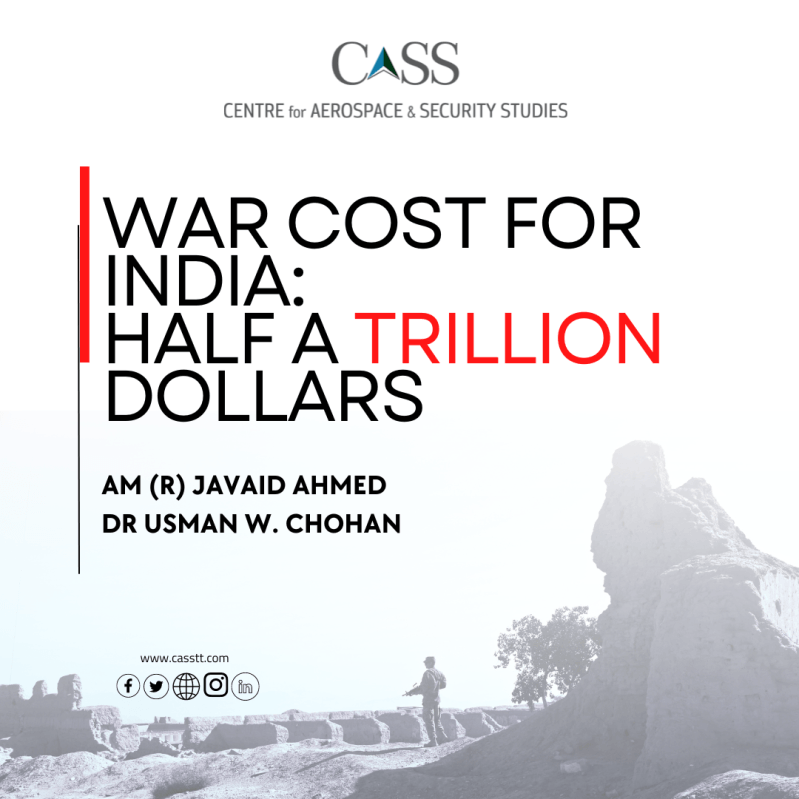War is a costly enterprise in every sense of the word, and if the hardline BJP regime provoked a full-scale conventional war with Pakistan, it is indisputable that India would pay very dearly. But just how dearly? We constructed a multifactor macroeconomic model, assessing aggregate output categories of consumption, government spending (civilian & military), investment, and foreign receipts, with key subcategories within each factor calculated and then normalized on a monthly basis.
By crunching the numbers in this manner, we came to get a sense of the devastation that would be wrought upon India. The findings of our macroeconomic analysis were that, in a four-week conventional war, India’s losses would exceed half a trillion dollars –at a minimum. This is by no means a trifling sum for a $3+ trillion economy.
If the damage approaches anywhere near this mark, India would face a GDP decline of nearly -20%, which is an amount seldom seen in recent history, except in the cases of catastrophic economic dissolution as experienced in Argentina (2001) and Greece (2010) during peacetime, and Iraq (2003) and Libya (2011) in wartime.
Why would the loss be so great? To put its plainly, because the costs of war are not just in the sets of cheques written by governments. Rather, they bear catastrophic losses when they disrupt or destroy human lives, military hardware, property, markets, savings, morale, psychology, and any semblance of sanity in society.
Imagine the convulsions to the regular course of life in India when a full-blown conventional war erupts. How many multinationals would halt or cancel investment plans? ($11bn+), how many retail activities would be shuttered indefinitely? ($51bn+), how badly would the market capitalization of their stock market collapse? ($250bn+), how many foreign investors would withdraw in capital flight? ($50bn+) how much disorder would flow out onto streets? ($3bn+) how much infrastructure would be damaged or in disrepair? ($10bn+), how many homes would go without electricity, water, and gas? ($0.5bn), how many flights would be grounded? ($0.2bn), how much of the military capability would need to be rebuilt? ($15bn+), and how many would-be tourists would cancel their travel? ($14bn+).
These are but some of the costs which we calculated and aggregated into comprehensive macroeconomic model, and other variables we omit here for brevity. We note that this does not even begin to touch the ultimate fear – that of very limited nuclear exchange, since the loss in that instance would be near-incalculable and long-term.
To put things in perspective, we also applied the same modelling approach to Pakistan, and found that the damage would also be catastrophic, but not nearly as much in neither absolute nor relative terms. For a conventional war, this should not be surprising: India is a country seven times larger, and on a per-capita basis its economy is larger and growing at a faster rate. But to magnify the point, it is also a much more complex economy, and there are sectors in India which are incomparably larger than in Pakistan, whether it be the stock market capitalization, its tourism industry, its IT services industry, or its overall export volume, among others. Our analysis indicates that the economic damage of a 4-week conventional conflict would amount to 10% of Pakistan’s GDP, given the comparatively elemental structure of its socio-economy. All this is but a reflection of the larger glass house in which India sits. It is an axiomatic reminder that: the bigger they are, the harder they shall fall.
To cite an example of the speed with which losses are incurred in war, take the irresponsible and disastrous employment of the Indian Air force, when the Pakistan Air force shot down two Indian fighters which resulted in a loss of over $ 100 million in less than 5 minutes of air combat. As such, the half trillion-dollar ultimate figure in our study helps to frame India’s risks and stakes as a deterrent to further violence and conflict.
Yet the desperation of the BJP extremist government to latch on to power worsens by the day, particularly as the April 2019 election nears. India’s humiliated military, record unemployment, worsening inequality, and rampant corruption (as in the Rafale Deal), heightens the BJP’s thirst for vengeance. But India’s economic woes would be far worse if an all-out conflict broke out. Our study should assist those thinkers who now ponder the consequences of misadventures by the Indian military, particularly as the 2019 election nears.
Wars can escalate unpredictably, last longer than foreseen, draw down more resources, and prove difficult to end. Moreover, the state of ‘no peace, no war’ that trails a conflict worsens that economic uncertainty considerably. Furthermore, with 68% of its arms and hardware obsolete, and severe human resources and materiel issues, India should be more circumspect about confronting a large neighboring country.
As such, this study bolsters the claim that peace must prevail in South Asia, for without it, the region cannot realize its full economic potential – certainly not while its largest member, India, repeatedly absolves itself of its responsibilities to its people, to its neighbors, and to the world at large
We note that, in light of the harrowing economic damage and loss of life, any future government in India that would assume charge in the wake of such a devastating conflict would face almost insurmountable odds of reconstruction, and wallow in the economic repercussions of their forebears’ folly. The Indian leadership must be mindful of this – for as we may attempt to calculate the cost of a war, scarcely can we begin to calculate its ultimate price.
The authors of this study are directors at the Centre for Aerospace and Security Studies. They can be reached at [email protected]





